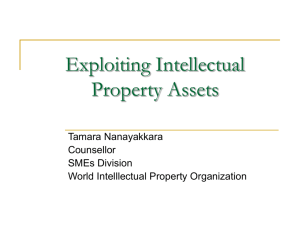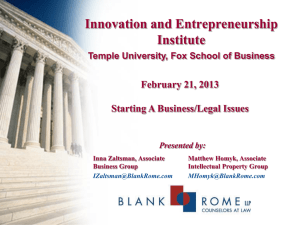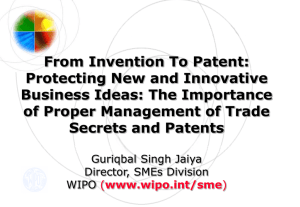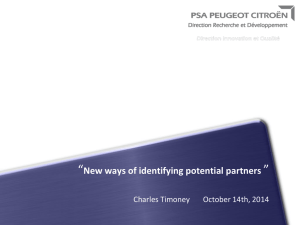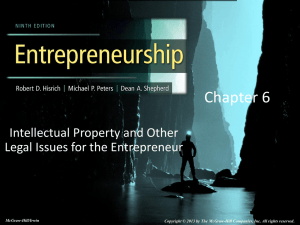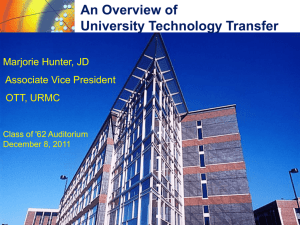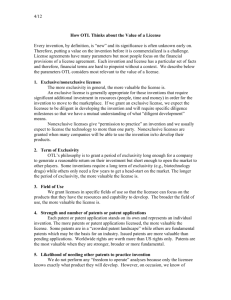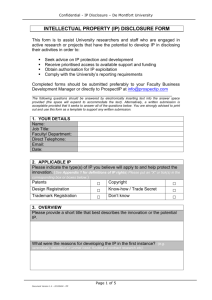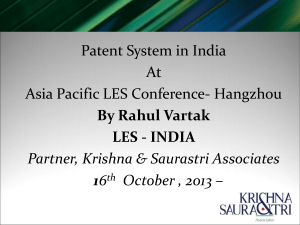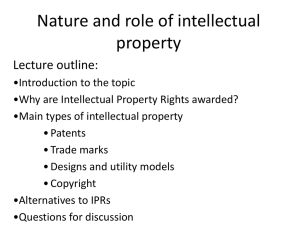Brand Identity Trademark Strategy 101
advertisement
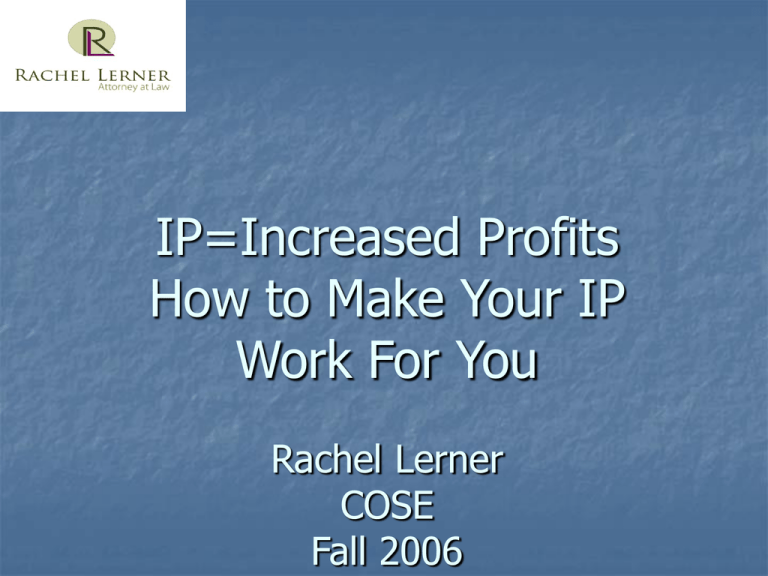
IP=Increased Profits How to Make Your IP Work For You Rachel Lerner COSE Fall 2006 IP…….Who Knew? Intellectual Property (“IP”) is often one of a company’s most valuable assets --Builds brand identity -Fosters consumer confidence -Distinguishes you from competitors -Protects Company investments What Is Intellectual Property? IP is intangible property that is the result of creativity such as – -trademark -copyright -patents -trade secrets What is a Trademark? A trademark is a word, symbol, design, or combination of a word and design which serves to identify and distinguish the goods or services of one source from those of another. Can be a sound (Harley Davidson) Smell (Yarn) Color (insulation) Examples of Trademarks Trademarks: What They Do Identify and designate the source and origin of products or services Represent a particular standard of quality Distinguish products and services bearing a company’s marks from those of other companies Symbolizes the GOODWILL of a company Protects a company’s investment in the development and promotion of its products Ensures consumers who want a company’s products get that company’s products TM Agreements TM License In; Use of 3rd party mark TM License Out; 3rd party uses your mark Advertising/Marketing Agreement Co-Brand Agreement Partnership Agreement Joint Development Agreement What Is Copyright? Original work of authorship Fixed in a tangible medium of expression Not idea only What Works Are Protected Not Protected Literary Works Musical Compositions Sound Recordings Visual Arts Audiovisual Works etc. Unfixed works; ideas Titles, names, short phrases, slogans Words with no original authorship etc. Internet and Wireless Content CONFIDENTIAL AND PROPRIETARY INFORMATION OF AmericanGreetings.com 2003 This work contains information that is confidential, privileged and proprietary information to AmericanGreetings.com. Removal of this notice, and use, examination, disclosure, transfer, and copying of all or part of this work are prohibited, except with the express written consent of AmericanGreetings.com Copyright Owner Has Exclusive Rights “Bundle of Sticks” To reproduce the work To prepare derivative works To distribute copies of the work To perform the work publicly To display the work publicly To perform sound recordings publicly by digital audio transmission Copyright AGREEMENTS Independent Contractor Content License Content Ownership Advertising Sponsorship Web Development Software Development PATENTS The exclusive right of a creator to manufacture, use, license or sell an invention for a number of years. Granted for a process, act or method that is new, useful and non-obvious Patent rights may be licensed, sold or assigned Patent Requirements Applicant must satisfy at least 4 conditions for US PTO 1. patentable subject matter 2. novelty; high threshold 3. useful; low threshold 4. No Prior Art: not obvious to one of ordinary skill in the art of having in mind earlier work of others Types of Patents Plant Patents; distinctive plants Design Patents; ornamental designs Utility Patents; machine or process Business Method Patents; methods of doing business Computer Software Cannot patent natural elements; mathematical formulas; abstract ideas Patent Licenses Patentee has exclusive right to license patent and to exclude others from using invention Can license rights to (1) make; (2) use; and (3) sell separately Potentially enormous revenue stream (especially for business method patents; technology patents) Patent Agreements Patent License Patent Assignment Development Agreement Joint Development Agreement Technology Agreements Trade Secrets Are Unique Unlike patents, trademarks and copyrights, there is never a registration or certificate to tell others a company is claiming info as a a trade secret The only definitive way to determine whether something is trade secret is to have a court ruling This makes it difficult for business planning but there are steps a business should take to protect info as a trade secret No Single Definition Trade secret Law is State driven; Each state has its on definition @43 states have adopted UTSA (including Ohio) Factors Courts consider: How widely known is the info? What security measures has company taken to protect info? How many people know the info? How valuable is the info to a business and its competitors (cocacola) How much $ has company invested to develop the info? How hard is it for a competitor to duplicate the info using proper methods? How To Protect Trade Secrets Trade secret protection program to protect trade secrets against misappropriation Business premise security Restrict disclosure only to those who have need to know Mark confidential info as confidential Non Disclosure Agreements Employees Third Parties consultants/developers/service providers Potential Business Partners Venture Capitalists Bankers/Advisors IP Agreements TM License; Company name Copyright License; Company content Patent License; Company invention NDA; Confidential information Employment Agreement Non-Compete Agreements with 3rd parties How Do I Remember All of This Stuff? Develop an IP Strategy including: -Plan to Identify Company IP -Plan to Register Core Company IP -Plan to Implement Company IP Policy -Use of Template Agreements for use of Company IP Thank You!
